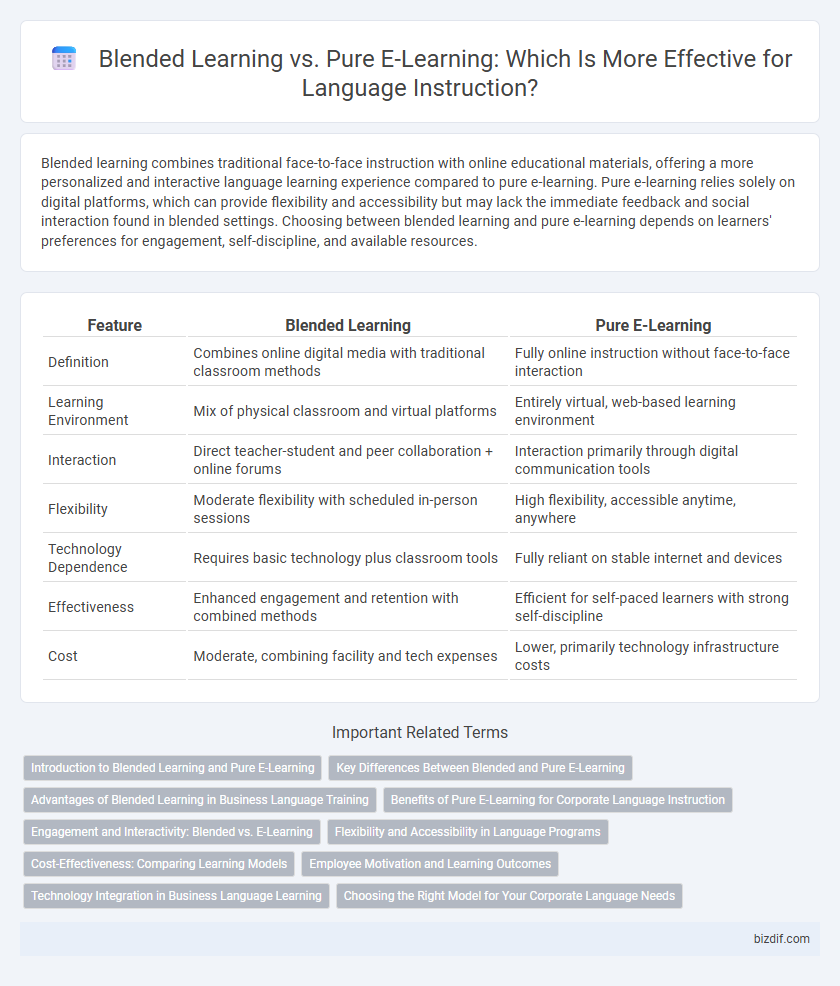Blended learning combines traditional face-to-face instruction with online educational materials, offering a more personalized and interactive language learning experience compared to pure e-learning. Pure e-learning relies solely on digital platforms, which can provide flexibility and accessibility but may lack the immediate feedback and social interaction found in blended settings. Choosing between blended learning and pure e-learning depends on learners' preferences for engagement, self-discipline, and available resources.
Table of Comparison
| Feature | Blended Learning | Pure E-Learning |
|---|---|---|
| Definition | Combines online digital media with traditional classroom methods | Fully online instruction without face-to-face interaction |
| Learning Environment | Mix of physical classroom and virtual platforms | Entirely virtual, web-based learning environment |
| Interaction | Direct teacher-student and peer collaboration + online forums | Interaction primarily through digital communication tools |
| Flexibility | Moderate flexibility with scheduled in-person sessions | High flexibility, accessible anytime, anywhere |
| Technology Dependence | Requires basic technology plus classroom tools | Fully reliant on stable internet and devices |
| Effectiveness | Enhanced engagement and retention with combined methods | Efficient for self-paced learners with strong self-discipline |
| Cost | Moderate, combining facility and tech expenses | Lower, primarily technology infrastructure costs |
Introduction to Blended Learning and Pure E-Learning
Blended learning combines traditional face-to-face instruction with digital online components, enhancing engagement and personalization in language education. Pure e-learning relies entirely on digital platforms, offering flexibility and accessibility for learners to study anytime and anywhere. Understanding these approaches helps educators design effective curricula that balance interaction and digital resources for optimal language acquisition.
Key Differences Between Blended and Pure E-Learning
Blended learning combines traditional face-to-face instruction with online digital media, offering interactive classroom experiences alongside flexible e-learning modules. Pure e-learning involves fully online courses without in-person contact, relying solely on digital platforms for content delivery, assessment, and communication. Key differences include learner engagement mechanisms, with blended learning fostering direct interaction and peer collaboration, while pure e-learning emphasizes self-paced study and remote accessibility.
Advantages of Blended Learning in Business Language Training
Blended learning in business language training enhances learner engagement by combining face-to-face interaction with digital resources, fostering practical communication skills essential for real-world business scenarios. This approach allows personalized feedback and adaptive learning paths, improving retention and skill application compared to pure e-learning platforms. Organizations benefit from increased flexibility, cost-effectiveness, and improved employee collaboration through synchronous and asynchronous learning modes.
Benefits of Pure E-Learning for Corporate Language Instruction
Pure e-learning in corporate language instruction offers unparalleled flexibility, allowing employees to access lessons anytime and anywhere, which significantly enhances learning efficiency and accommodates diverse schedules. The digital platform provides personalized learning paths through adaptive technology, ensuring that content meets each learner's proficiency level and accelerates language acquisition. Cost-effectiveness is another critical benefit, as companies save on physical materials, travel expenses, and instructor fees while reaching a broader audience across multiple locations.
Engagement and Interactivity: Blended vs. E-Learning
Blended learning combines face-to-face interaction with online activities, enhancing student engagement through diverse instructional methods and collaborative opportunities. Pure e-learning relies solely on digital platforms, requiring interactive multimedia and real-time feedback tools to maintain learner motivation. Studies show blended formats often achieve higher engagement levels due to the integration of social interaction and hands-on experiences unavailable in fully online environments.
Flexibility and Accessibility in Language Programs
Blended learning in language programs offers greater flexibility by combining face-to-face interaction with online resources, allowing learners to benefit from real-time feedback and self-paced study. Pure e-learning provides unmatched accessibility, enabling learners to access materials anytime and anywhere, which is especially beneficial for those with varying schedules or in remote locations. While blended learning enhances engagement through diverse formats, pure e-learning maximizes convenience, making both essential for comprehensive language education.
Cost-Effectiveness: Comparing Learning Models
Blended learning reduces costs by combining online digital media with traditional face-to-face instruction, lowering expenses related to physical infrastructure and commuting. Pure e-learning eliminates most in-person costs but may require higher investment in robust digital platforms and learner support systems. Research shows blended models often achieve better cost-effectiveness by optimizing resource allocation and enhancing learner engagement compared to fully online counterparts.
Employee Motivation and Learning Outcomes
Blended learning combines face-to-face interaction with online modules, enhancing employee motivation through social engagement and immediate feedback, which often leads to higher retention rates and improved learning outcomes. Pure e-learning offers flexibility and self-paced study, but may result in lower motivation due to lack of direct interaction and limited accountability. Organizations leveraging blended approaches report a 25% increase in knowledge retention and a 40% boost in learner satisfaction compared to purely digital courses.
Technology Integration in Business Language Learning
Blended learning combines face-to-face interaction with digital tools, enhancing business language acquisition through interactive platforms, multimedia content, and real-time feedback. Pure e-learning relies solely on technology, offering flexible, self-paced courses but may lack the personalized engagement crucial for practical language skills in business contexts. Integrating technologies like AI-driven language tutors and video conferencing in blended models optimizes learner outcomes by balancing automation with human interaction.
Choosing the Right Model for Your Corporate Language Needs
Blended learning combines face-to-face instruction with digital courses, offering personalized interaction and flexibility that can enhance employee engagement in corporate language training. Pure e-learning relies solely on online platforms, providing cost-effective scalability but may lack the immediate feedback and social dynamics crucial for language acquisition. Evaluating your organization's size, learner preferences, and communication goals helps determine whether a hybrid or fully digital model aligns best with your corporate language needs.
Blended learning vs Pure e-learning Infographic

 bizdif.com
bizdif.com